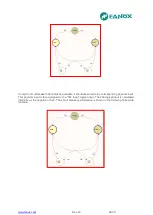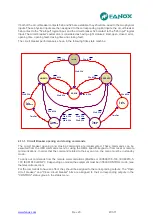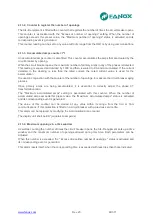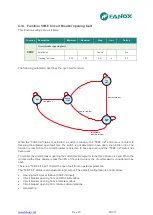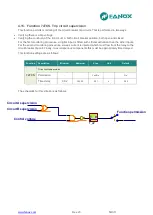
Rev.23
35/311
If the unit operates as a definite time, the starting up of the function occurs with 100% of adjusted tap,
and it resets with the 95%.
If the unit operates with curve, the starting up of the function occurs with the 110% of the adjusted tap
and it resets with the 100%. Reset is instantaneous in both cases.
Action time accuracy is ±5% or ±30ms highest of both, over theorical time of action.
Used curves are IEC 60255-151 and IEEE, which are described on corresponding section of this
manual.
4.6.
Function 49. Thermal image protection
Thermal image is a measure of heating and cooling of an electric machine. Unlike overcurrent protection,
do not start counting the time when it detects a fault, but is continuously determining the thermal state
of the machine that monitors. The trip time depends on the thermal constants adjusted, the current
flowing and the prior thermal state of the machine.
The thermal image is calculated based on the following equation:
θ = 100 x (I/I
t
)
2
x (1
– e
-
t/ζ
) + θ’
0
x e
-
t/ζ
where :
•
I, máximum r.m.s. current of three phases
•
I
t,
adjusted tap current
•
ζ, termal constant
•
θ’
0
, initial termal state
The trip time is given by the equation:
t =
ζ x ln { [(I/I
t
)
2
–
(θ’
0
/ 100)
] / [(I/I
t
)
2
- 1] }
The algorithm uses the maximum of the three phase currents. If the maximum is greater than 15% of
the adjusted tap, heating thermal constant is applied. If the maximum is less than 15% of the adjusted
tap cooling thermal constant is taken into account.
The overload function trips when the thermal image reaches the value of 100%. This value is reached
in time when the current flowing is equal to the function adjusted in thermal function.
It provides an adjustable level of thermal imaging to generate an alarm. If the trip occurs, the function of
overload is reset when the thermal image falls below the set alarm level.
As the current measurement algorithm used is r.m.s., in the thermal model is taken into account the
heat produced by the harmonics.
This protection function is adjusted by setting five different parameters
:
Summary of Contents for SIL B
Page 1: ...EN_FANOXTD_MANU_SIL_Feeder_SILB_R023 Docx USER S MANUAL SIL B Feeder Relay...
Page 8: ...www fanox com Rev 23 8 311 2 DIMENSIONS AND CONNECTION DIAGRAMS 2 1 Equipment front view...
Page 9: ...www fanox com Rev 23 9 311 2 2 Equipment dimensions...
Page 10: ...www fanox com Rev 23 10 311...
Page 11: ...www fanox com Rev 23 11 311 2 3 Cut out pattern CUT OUT PATTERN...
Page 12: ...www fanox com Rev 23 12 311 2 4 Connection diagrams Analog connections...
Page 13: ...www fanox com Rev 23 13 311...
Page 14: ...www fanox com Rev 23 14 311 Digital connections Outputs and Trip circuit supervision...
Page 15: ...www fanox com Rev 23 15 311 2 5 Terminals IEC 61850 or DNP3 0 protocols...
Page 17: ...www fanox com Rev 23 17 311 IEC 60870 5 103 protocol...
Page 25: ...www fanox com Rev 23 25 311 3 3 Functional diagram...
Page 28: ...www fanox com Rev 23 28 311 3 5 1 SIL B 1 CHARGE CURVE 3 5 2 SIL B 5 CHARGE CURVE...
Page 91: ...www fanox com Rev 23 91 311...
Page 140: ...www fanox com Rev 23 140 311...
Page 194: ...www fanox com Rev 23 194 311 Polarization V 35 0 V C Operating Angle 180 C Halfcone Angle 3 C...
Page 307: ...www fanox com Rev 23 307 311 50BF init Fault init 79 Closure permission 52 closure permission...
Page 310: ...www fanox com Rev 23 310 311 NOTES...
Page 311: ...www fanox com Rev 23 311 311...


























